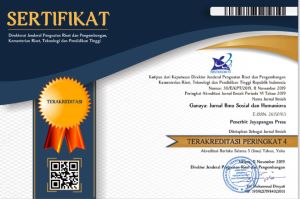A Thematic Analysis of Beauty Influencers Narrative Strategies on Instagram From the Audience's Perspective
DOI:
https://doi.org/10.37329/ganaya.v8i2.4221Keywords:
Narrative Strategy, Instagram, Beauty InfluencerAbstract
Instagram has become a primary platform for beauty influencers to build connections with their audiences through engaging narrative strategies. This study examines the narrative techniques employed by beauty influencers on Instagram and explores how audiences respond to these elements. Using a thematic analysis approach, the study examines narrative elements such as story personalization, content authenticity, and value relevance. This study employs a qualitative approach to explore and understand the experiences of Instagram users who follow beauty influencers. Data collection was conducted through in-depth interviews with three active followers of beauty influencers on Instagram. Through thematic analysis, the findings indicate that narrative elements such as coherence and fidelity are instrumental in shaping audience perceptions, fostering trust, and influencing purchase decisions related to promoted products. Narrative strategies that emphasize honesty, cultural relevance, and real experiences foster stronger emotional connections between influencers and their audiences. Moreover, visually driven narratives, such as before-and-after videos and product journey content, are particularly effective in building trust and enhancing the impact of digital marketing efforts. This research underscores the importance of a narrative approach in building emotional connections between brands, influencers, and audiences. By understanding the effective elements of narrative strategies, marketers can create campaigns that are more relevant, authentic, and impactful in the digital era.
References
Audrezet, A., Kerviler, G. D., & Moulard, J. G. (2020). Authenticity Under Threat: When Social Media Influencers Need To Go Beyond Self-Presentation. Journal of Business Research, 117, 557-569.
Audrezet, A., Kerviler, G. D., & Moulard, J. G. (2018). When Authenticity Matters: Balancing Morality And Functionality In Influencer Marketing. Journal of Business Research, 88, 199-208.
Byrne, E., Kearney, J., & MacEvilly, C. (2017). The Role Of Influencer Marketing And Social Influencers In Public Health. Proceedings of the Nutrition Society, 76(OCE3), E103.
Braun, V., Clarke, V., & Weate, P. (2017). Using Thematic Analysis In Sport And Exercise Research. Routledge Handbook Of Qualitative Research In Sport And Exercise (pp. 191-205). London: Routledge.
Brechman, J., & Purvis, S. C. (2015). Narrative Persuasion: Using Storytelling To Increase Impact. Journal of Advertising Research, 55(4), 397-406.
Byrne, D. (2022). A Worked Example Of Braun And Clarke’s Approach To Reflexive Thematic Analysis. Quality & quantity, 56(3), 1391-1412.
Casaló, L. V., Flavián, C., & Ibáñez-Sánchez, S. (2020). Influencers On Instagram: Antecedents And Consequences Of Opinion Leadership. Journal of business research, 117, 510-519.
Clarke, V., & Braun, V. (2017). Thematic analysis. The Journal of Positive Psychology, 12(3), 297-298.
Djafarova, E., & Trofimenko, O. (2019). Exploring The Credibility Of Online Celebrities' Instagram Profiles In Influencing The Purchase Decisions Of Young Female Users. Computers in Human Behavior, 106, 106-278.
De Veirman, M., Cauberghe, V., & Hudders, L. (2017). Marketing Through Instagram Influencers: The Impact Of Number Of Followers And Product Divergence On Brand Attitude. International Journal of Advertising, 36(5), 798-828.
Fisher, W. R. (1984). Narration As A Human Communication Paradigm: The Case Of Public Moral Argument. Communication Monographs, 51(1), 1-22.
Jin, S. V., Muqaddam, A., & Ryu, E. (2019). Instafamous And Social Media Influencer Marketing. Marketing Intelligence & Planning, 37(5), 567-579.
Lim, X. J., Radzol, A. M., Cheah, J. H., & Wong, M. W. (2017). The Impact Of Social Media Influencers On Purchase Intention And The Mediation Effect Of Customer Attitude. Asian Journal of Business Research, 7(2), 19-36.
Latiff, Z. A., & Safiee, N. A. S. (2015). New Business Set Up For Branding Strategies On Social Media-Instagram. Procedia Computer Science, 72, 13-23.
Lou, C., & Yuan, S. (2019). Influencer Marketing: How Message Value And Credibility Affect Consumer Trust Of Branded Content On Social Media. Journal of Interactive Advertising, 19(1), 58-73.
Marwick, A. E. (2015). Instafame: Luxury Selfies In The Attention Economy. Public Culture, 27(1), 137-160.
Roselina, S., Rahmat, D., & Rachmawati, F. (2021). Instagram As A Marketing Media For Small Business In The Pandemic Era. International Journal of Entrepreneurship and Business Development, 4(1), 115-125.
Zhou, J., Blazquez, M., & McKinney, A. (2021). Authenticity In The Influencer Marketing Context: A Cross-Cultural Investigation. Journal of Business Research, 132, 632-643.
Zhou, J., Wang, L., & Zhang, C. (2021). Beauty Influencers On Instagram: The Role Of Self-Disclosure And Para-Social Interaction In Consumer Behavior. Telematics and Informatics, 64(7), 101688.
Downloads
Published
How to Cite
Issue
Section
License
Copyright (c) 2025 Evelyne Trisa Diandra Jacub (Author)

This work is licensed under a Creative Commons Attribution-ShareAlike 4.0 International License.
An author who publishes in the Ganaya : Jurnal Ilmu Sosial dan Humaniora agrees to the following terms:
- Author retains the copyright and grants the journal the right of first publication of the work simultaneously licensed under the Creative Commons Attribution-ShareAlike 4.0 License that allows others to share the work with an acknowledgement of the work's authorship and initial publication in this journal
- Author is able to enter into separate, additional contractual arrangements for the non-exclusive distribution of the journal's published version of the work (e.g., post it to an institutional repository or publish it in a book) with the acknowledgement of its initial publication in this journal.
- Author is permitted and encouraged to post his/her work online (e.g., in institutional repositories or on their website) prior to and during the submission process, as it can lead to productive exchanges, as well as earlier and greater citation of the published work (See The Effect of Open Access).
Read more about the Creative Commons Attribution-ShareAlike 4.0 Licence here: https://creativecommons.org/licenses/by-sa/4.0/.








